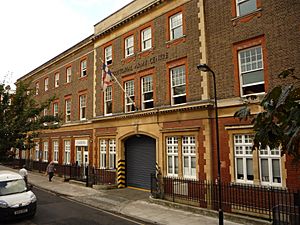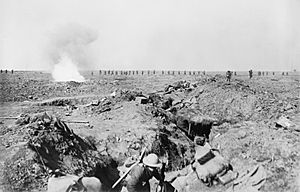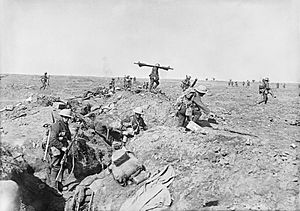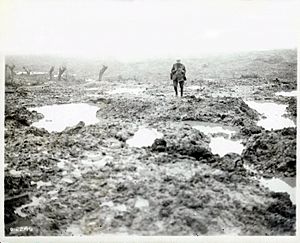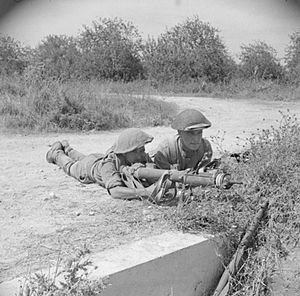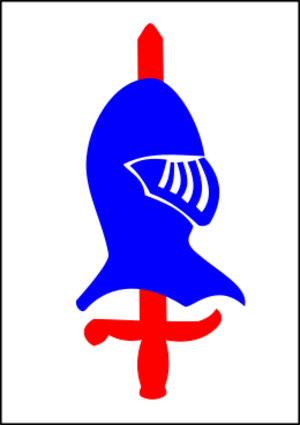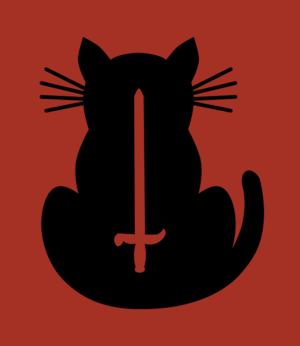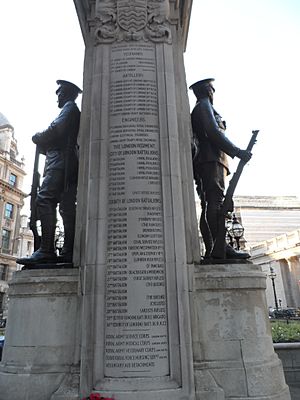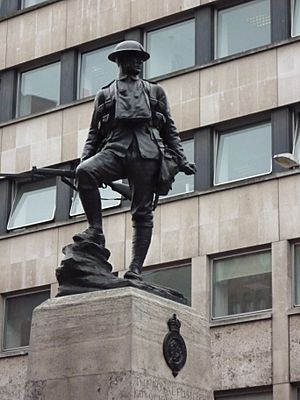1st (City of London) Battalion, London Regiment (Royal Fusiliers) facts for kids
Quick facts for kids 19th (Bloomsbury) Middlesex RVC1st Volunteer Bn, Royal Fusiliers 1st Bn, London Regiment 8th Bn, Royal Fusiliers City of London Bn, Royal Fusiliers |
|
|---|---|
| Active | 13 December 1859–1 April 1967 |
| Country | |
| Branch | |
| Type | Infantry Battalion |
| Role | Infantry |
| Size | 1–4 Battalions |
| Part of | London Regiment Royal Fusiliers |
| Garrison/HQ | 101 St Martin's Lane 33 Fitzroy Square Handel Street, Bloomsbury |
| Nickname(s) | 'Tom Brown's Corps' |
| Mascot(s) | A duck (1943–45) |
| Engagements | |
| Commanders | |
| Notable commanders |
Thomas Hughes |
The 1st (City of London) Battalion, London Regiment (Royal Fusiliers) was a special volunteer army unit. It was started in 1859 in Bloomsbury, London. The famous author of Tom Brown's Schooldays, Thomas Hughes, helped create it.
This unit served in many important conflicts. During World War I, they fought in places like Malta, Gallipoli, Egypt, and on the Western Front. In World War II, they saw action in Iraq, North Africa, and Italy. The unit later joined with other similar groups in the 1960s.
Contents
Starting the Volunteer Force
In 1859, many people in Britain worried about a possible invasion. This led to a big wave of excitement for the Volunteer movement. Lots of new Rifle Volunteer Corps (RVCs) were formed. These were groups of part-time soldiers. They wanted to help the regular British Army if needed.
One of these new units was the Working Men's College Rifle Volunteers. It was started by Thomas Hughes. He was the author of the famous book Tom Brown's Schooldays. On December 13, 1859, this group was officially recognized. It became the 19th (Bloomsbury) Middlesex Rifle Volunteer Corps.
The first soldiers came from the Christian Socialist Working Men's College in Bloomsbury. Thomas Hughes taught there. Later, more volunteers joined from other colleges and from different jobs. These included skilled workers, clerks, and sailors. Hughes believed his unit was the poorest in London. Most other volunteer groups were made up of middle-class people. Hughes was a strong supporter of the Volunteer Movement.
The unit's first chaplain was Rev Frederick Denison Maurice. He was a Christian Socialist and helped start the Working Men's College. By 1866, the unit's main office was at 101 St Martin's Lane. It later moved to 33 Fitzroy Square.
Thomas Hughes stopped being the commander in 1869. He was then made the unit's first Honorary Colonel. Another unit, the 37th Middlesex RVC, asked to be the only one with 'Bloomsbury' in its name. The 19th Middlesex agreed and dropped 'Bloomsbury' from its title.
Over the years, the British Army changed how it was organized. In 1880, the 19th Middlesex became the 10th Middlesex RVC. Then, in 1883, it changed again. It became the 1st Volunteer Battalion, Royal Fusiliers (City of London Regiment). This meant it was now part of the Royal Fusiliers regiment.
Fighting in the Second Boer War
In 1899, the Second Boer War began in South Africa. Volunteers were asked to help the regular soldiers. The 1st, 2nd, and 3rd Volunteer Battalions of the Royal Fusiliers formed a special company. This company joined the 2nd Royal Fusiliers in South Africa in May 1900. Another group, G Company, was also formed. They were part of the City of London Imperial Volunteers (CIV).
The CIV returned to London in 1900. But the special service company stayed with the regular troops. They went on long marches and guarded blockhouses. More volunteer companies joined later. For their service, the battalion earned a special honor: South Africa 1900–1902.
Becoming the Territorial Force
In 1908, the Volunteer Force became the new Territorial Force (TF). This was part of the Haldane Reforms. Volunteer units in London formed a new London Regiment. The 1st Volunteer Battalion of the Royal Fusiliers became the 1st (City of London) Battalion, the London Regiment (Royal Fusiliers). People often called them the '1st Londons'.
In 1913, the TF built a new main office and training hall. It was at Handel Street, Bloomsbury. The battalion shared this building with another unit. The main office and six companies were at Handel Street. Two other companies were based in Battersea.
World War I
Getting Ready for War
On August 2, 1914, the 1st London Division was on its way to a training camp. But they quickly received orders to return to London. War was about to start. By August 3, the battalions were ready. They were guarding the important railway line between Waterloo and Southampton Docks. The 1st Londons got ready at Handel Street. Colonel P.B.G.O. Crowe was their commanding officer.
The TF was meant for home defense. Its members could not be forced to fight overseas. But on August 10, 1914, TF units were asked to volunteer for service abroad. Most of them agreed. On August 31, the 1st London Brigade was ordered to prepare for duty overseas. They were going to replace the regular army soldiers in Malta.
Each battalion left behind a small group of soldiers. These were mostly men who were not fit or did not volunteer for overseas service. This group formed a new '2nd Line' battalion. It was called the 2/1st London Brigade. Later, a '3rd Line' was formed to provide new soldiers for the 1st and 2nd Lines. A '4th Line' battalion was also created later.
1/1st Londons in Action
Malta and France
The 1/1st London Brigade sailed from Southampton on September 4, 1914. They arrived in Malta on September 14. Their job was to guard the island. They also started training as the weather cooled. The 1/1st Londons were at St Andrews Barracks.
In January 1915, the brigade was told to get ready to leave Malta. They were replaced by the 2/1st London Brigade. The 1/1st Londons sailed to England in February. On March 11, they landed in Le Havre, France. They joined the British Expeditionary Force (BEF) on the Western Front. They became part of the 25th Brigade, which was part of the 8th Division. The 8th Division had just finished a tough battle. The new soldiers were very welcome.
Trench Warfare on the Western Front
The 8th Division attacked again on May 9 at the Battle of Aubers Ridge. The 1/1st Londons were new to fighting. They were not sent into the main attack. The attack was very difficult. Soldiers got into enemy trenches but could not go further. The fighting stopped that night. The 1/1st Londons spent the summer learning about Trench warfare.
On September 25, the 8th Division made another attack. This was to distract the enemy from the main Battle of Loos. The 1/1st Londons stayed in support. They helped dig a new trench that night. This made the British front line shorter and stronger.
In February 1916, the 1st London Division came back together in France. The 1/1st Londons joined the 167th (1st London) Brigade. The battalions got new training. They learned to use Lewis guns and hand grenades. In May, the 1/1st Londons got more soldiers. They absorbed the 2/1st Londons, who had just returned from Egypt.
The Somme Battles
On May 4, the 167th Brigade moved to Hébuterne. They prepared for the big attack of the summer, the Battle of the Somme. The 1/1st Londons and 1/7th Middlesex took turns holding the front lines. They were about 700 yards from the German positions. For the attack, they needed a new trench closer to the enemy. They dug this new trench over several nights. The work was hard and dangerous. The 1/1st Londons had about 34 casualties during this digging.
The main attack began on July 1. This was the First day of the Somme. The 56th (1st L) Division's attack started well. But the leading soldiers were cut off by heavy German fire. The 1/1st Londons were kept in their reserve trench. Even though they did not attack, they still had 81 casualties that day.
The division then moved south. They trained with the first tanks to arrive in France. On September 9, the 56th (1st L) Division launched the Battle of Ginchy.
For the bigger Battle of Flers–Courcelette on September 15, the 167th Brigade attacked. The 1/1st London led the attack. They had two new tanks helping them. But one tank broke down, and the other was hit. The battalion took the enemy trenches. But they had many casualties. The attack was stopped. The fighting continued with small attacks. The 1/1st Londons and 1/7th Middlesex took 'Middle Copse'.
On September 25, the division attacked again in the Battle of Morval. The 1/1st Londons pushed forward. They helped in the capture of Combles. In October, the 167th Brigade held a line in deep mud. They attacked again on October 7 in the Battle of Le Transloy. But they faced strong machine gun fire and did not advance much. The division was then relieved.
The next few months were quieter. The 56th (1st L) Division slowly rebuilt its strength. The 1/1st Londons reached a strength of 1062 soldiers. They were ready for new operations in March 1917.
Arras and Ypres
In March 1917, the 56th (1st L) Division prepared for the Battle of Arras. On April 9, the attack began. The 1/1st Londons were in support. They advanced through the first lines of trenches. But they faced heavy fire and had many casualties. Their commanding officer, Lt-Col Smith, was badly wounded. The fighting continued all night. They finally reached their objective the next day. The brigade was relieved after four days of fighting in thick mud.
The 56th (1st L) Division attacked again on May 3 in the Third Battle of the Scarpe. The 1/1st Londons led the attack. But the German defenses were very strong. The attack was stopped quickly. Many soldiers were killed or captured. The brigade was withdrawn on May 5.
After Arras, the BEF prepared for the Third Ypres Offensive. In August, the 56th (1st L) Division moved to the Ypres Salient. They took part in the Battle of Langemarck on August 16. The battlefield was very muddy. The 167th Brigade struggled to advance. They faced marshes and enemy fire. They gained only about 400 yards. The brigade later withdrew to a better position.
Cambrai and the Spring Offensive
The division was sent to a quiet area because of their losses. On November 20, they made a fake attack. This was to help the main tank attack at the Battle of Cambrai. The fake attack worked. It drew German fire. The 167th Brigade was not directly involved in the main fighting. They helped dig defenses when the Germans counter-attacked. The 1/1st Londons still had 783 soldiers at the end of the battle.
In February 1918, the BEF reduced its number of battalions. The 1/3rd Londons were disbanded. Their soldiers joined the remaining battalions, including the 1/1st Londons. From then on, the 1/1st Londons were simply called '1st Londons'.
The 56th (1st L) Division was in the Gavrelle area when the German spring offensive began on March 21. On March 28, the Germans attacked again. The 1st Londons were in reserve. The British held their lines. The German attack was stopped. The 1st Londons then relieved the other brigades. There were no more attacks the next day. The division was relieved on March 29.
For the next four months, the 56th (1st L) Division held trenches. They also carried out small raids. In July, they were relieved and began intense training.
The Hundred Days Offensive
The Allies' Hundred Days Offensive began on August 8. The 56th (1st L) Division joined in the Battle of Albert on August 23. The 167th Brigade attacked the next day. The 1st Londons were on the right. They easily took 'Summit Trench'. But then they heard about German reinforcements. The division was ordered to prepare for a counter-attack. The 167th Brigade tried to take the village of Croisilles. But the village was strongly defended. The attack was called off. The 1st Londons were heavily shelled with gas that night. A new attack on August 26 failed. The brigade was then relieved. They returned to the front on August 27. By then, the enemy had left Croisilles.
The 56th (1st L) Division returned to the line near Cambrai in September. On September 27, the Battle of the Canal du Nord began. The 56th (1st L) Division advanced along the canal. They cleared both banks. The 167th Brigade was in reserve. They later entered Palluel. After the Battle of Cambrai in October, the Germans began to retreat. The 167th Brigade sent patrols into Arleux.
The 56th (1st L) Division rested in October. They returned on November 1 for the Battle of the Sambre. The 167th Brigade was to clear the area as far as the Aunelle river. But on November 3, patrols reported that the enemy had already left. The advance continued with little opposition. On November 5, the 168th Brigade was pushed back at the Grand Honnelle river. The 167th Brigade took over on November 6. They found the enemy had retired. They crossed the Grand Honnelle that night.
The 167th Brigade led the advance on November 7 and 8. They met little opposition. On November 9, the division continued to advance. The 1st Londons provided outposts for the night. On November 10, the 1st Londons advanced behind the 16th Lancers. They cleared the ground and entered Harmignies.
The 56th (1st L) Division was relieved on the night of November 10. The war ended at 11:00 AM the next day. This was when the Armistice with Germany began. The division stayed around Harveng for the winter. Soldiers began to go home in December. The 1st (City of London) Battalion, London Regiment, was officially disbanded on June 6, 1919.
Commanding Officers
These officers led the 1/1st Londons during the war:
- Col P.B.G.O. Crowe, VD (at the start of the war)
- Lt-Col E.G. Mercer, CMG, TD (January–June 1916)
- Lt-Col D.V. Smith, DSO, VD (June–October 1916 and February–April 1917, he was mortally wounded)
- Lt-Col Kennard (October–November 1916)
- Lt-Col W.R. Glover, CMG, DSO, TD (November 1916–March 1917 and April 1917 until the Armistice)
2/1st Londons in Action
When the 1/1st Londons went to Malta in September 1914, the 2/1st Bn was already forming. They had a serious lack of equipment. At first, they used wooden practice rifles. Later, they got some .256-inch Japanese Ariska rifles. In December 1914, the 2/1st London Brigade gathered in Maidstone in Kent.
Malta and Gallipoli
From Maidstone, the brigade was sent to Malta. They were to replace the 1/1st London Brigade. The 1/1st Londons left on February 11, 1915. They left their older rifles and machine guns for the new soldiers. In Malta, the 2/1st London Brigade continued training. They also guarded the coast and prisoners of war. In July, they were ordered to prepare for service in Egypt. The 2/1st Londons left for Alexandria on August 27.
The brigade gathered at Abbassia Camp in Cairo. They prepared to help the soldiers fighting at Gallipoli. The 2/1st and 2/3rd Londons went first in September. They were sent to help the 29th Division. The 2/1st Londons landed at W Beach, Suvla, around midnight on September 24. They were given modern Short Lee-Enfield rifles.
The battalion had its first casualties on September 28. They spent time in the firing line. By the end of November, many soldiers were sick or wounded. On December 18, the battalion was pulled out of the line. They left Suvla as part of the evacuation. After a week's rest, they landed at V Beach at Cape Helles. The 2/1st Londons were finally withdrawn on January 7, 1916, during the evacuation of Helles.
The battalion returned to Egypt. They rested and reorganized. In April, the 2/1st London Brigade gathered at Sidi Bishr Camp in Alexandria. On April 17, the whole brigade sailed to Marseilles, France.
Disbandment
Once in France, the 2/1st Londons moved to Rouen. In May, they were broken up. Most of their soldiers joined the 1/1st Londons. Meanwhile, the 3/1st Londons (who were training in the UK) were renamed the 'New' 2/1st Bn.
3/1st and New 2/1st Londons
The 3/1st Londons were formed in January 1915. Their job was to train new soldiers for the battalions overseas. In April, the 3rd Line battalions gathered at Tadworth in Surrey. This was called the 3/1st London Brigade. In May, soldiers who were not fit for overseas service were moved to other units. The 3/1st Londons were now treated as a 'service' battalion. A new 4/1st Londons unit was formed to train new soldiers. The 3/1st London Brigade moved to Bury St Edmunds and then to Ipswich.
The 58th (2/1st L) Division, which included the 3/1st Londons, had trouble training due to lack of equipment. In February 1916, they received many new recruits. In Spring 1916, they took over coast defense duties. In June, the 3/1st Londons were renamed the 2/1st Bn. On July 10, 1916, the 58th (2/1st L) Division gathered for final training. They got new Lee–Enfield rifles. In December, the division was ready for overseas service.
In January 1917, the battalion sailed to Le Havre, France. In February, they went into the front line for the first time. This was at Ransart, south of Arras. It was a quiet area. From February to April, the 58th Division advanced quickly. They followed the German retreat to the Hindenburg Line. They then worked to repair roads and railways.
Bullecourt and Ypres
On May 13, the 173rd Brigade relieved the Australian soldiers at the Second Battle of Bullecourt. The 2/1st Londons were in reserve. On May 16, a company of 2/1st Londons captured part of the Hindenburg Support Line. On May 17, the rest of the 58th (2/1st L) Division secured Bullecourt village.
On June 15, the 173rd Brigade attacked a section of the Hindenburg Line. The 2/1st Londons were part of this attack. They faced many German pillboxes. They took their objectives. The next day, they attacked again. But they got too far forward and were cut off. Many soldiers were captured. No gains were made, and casualties were heavy.
The 58th (2/1st L) Division rested and trained after Bullecourt. In late August 1917, they moved to the Ypres Salient. On September 14, a company of 2/1st Londons made a raid. It was a disaster. Many men were reported missing. During the Battle of the Menin Road Ridge on September 20, the 2/1st Londons were in reserve.
The division returned to the line for the Second Battle of Passchendaele. The weather was terrible. The battlefield was deep in mud. On October 26, the brigade attacked. They struggled through the mud. Their rifles were too muddy to fire. They could not reach their objective. They were pushed back by a counter-attack. In the following days, the 2/1st Londons helped carry wounded soldiers.
The 58th (2/1st L) Division stayed at Poelcappelle through November and December. In January 1918, they moved south. In February, the BEF disbanded some battalions. The 2/1st Londons were chosen from the 173rd Brigade. On February 6, 1918, the battalion was disbanded. Its soldiers were sent to other battalions. At this point, the 1/1st Londons became simply 1st Londons.
4/1st Londons
The 4/1st Battalion was formed in May 1915. Its job was to train new soldiers. In January 1916, all the reserve battalions gathered at Hurdcott. On April 8, the unit's name changed to 1st (Reserve) Bn, London Regiment. This unit continued to train recruits until the end of the war. It was disbanded on August 15, 1919.
29th Londons
In June 1915, soldiers from the 3/1st London Brigade who were not fit for overseas service formed a new unit. This was the 100th Provisional Battalion. They were stationed at Aldeburgh. They guarded the East Coast. In 1916, this unit became the 29th (City of London) Battalion, London Regiment. This battalion never served overseas. It was disbanded in early 1919.
It is thought that about 9408 men served in the 1st Londons during the war. Another 3681 men passed through the 29th Londons.
Between the World Wars
The Territorial Force (TF) was reformed on February 7, 1920. The battalion reformed at Handel Street. In 1922, the battalion's name was simplified. It became the 1st City of London Battalion, London Regiment (Royal Fusiliers). The TF was renamed the Territorial Army (TA) in 1921. The battalion was part of the 167th (1st London) Brigade.
The London Regiment was officially disbanded in 1938. On August 31, 1937, the battalion joined the Royal Fusiliers. Its new name was 8th (1st City of London) Battalion, Royal Fusiliers (City of London Regiment).
World War II
Getting Ready for War
After the Munich Crisis, the TA doubled in size. The 8th Royal Fusiliers formed a second battalion. This was the 2/8th Battalion, created in April 1939. It was soon renamed the 11th Battalion.
On September 1, 1939, the TA was fully called up. This was two days before war was declared. The 8th Royal Fusiliers got ready at Handel Street. Lt-Col E.H.L. White was their commander. The 8th Royal Fusiliers were in the 1st London Brigade. The 11th Royal Fusiliers were in the 4th London Brigade.
8th Royal Fusiliers in Action

After getting ready, the battalion moved to Stoke Newington. Then, on October 30, they went to Crowborough in East Sussex. The 1st London Division was an anti-invasion unit. In May 1940, during the Dunkirk evacuation, it was sent to East Kent. The 8th Royal Fusiliers used borrowed civilian vehicles to move. The division was then reorganized as a regular infantry division. On November 18, 1940, it got its old name back: 56th (London) Division.
By then, the 8th Royal Fusiliers were stationed behind Dover. In February 1941, they moved to Hawkhurst. Then they moved to the coast between Lydd and Dungeness. They stayed there for six months. On November 15, 1941, the 56th (L) Division moved to East Anglia. The 8th Royal Fusiliers were at Colchester in Essex. In early 1942, they moved to Woodbridge, Suffolk. They camped in Rendlesham Forest. On July 23, 1942, Lt-Col E.A. Poulton became the new commanding officer.
Iraq and North Africa
The 8th Royal Fusiliers sailed from Gourock on August 25, 1942. The convoy carried the 56th (L) Division. They stopped in Sierra Leone and Cape Town. Then they went to Bombay. From there, they sailed to Basra in Iraq. They arrived on November 4. The 8th Royal Fusiliers then took a 600-mile train journey to Kirkuk. The division was meant to help in Persia and Iraq. But the threat there had lessened. So, the troops trained for service elsewhere. The 56th (L) Division was chosen for the planned invasion of Sicily.
The 56th (L) Division then moved to Tunisia. This was a long journey of about 3200 miles. They arrived on April 19, 1943. The 167 and 169 Brigades were sent into the last stages of the Tunisian Campaign. General Bernard Montgomery wanted to use experienced troops for Sicily.
The division went into action again during the final advance on Tunis. On the evening of May 9, the 167 Brigade attacked 'Razorback Ridge'. The 8th and 9th Royal Fusiliers led the attack. They had Valentine tanks helping them. The soldiers advanced across an open valley. They were covered by a smokescreen from the artillery. But they suffered many casualties from enemy fire. The leading companies reached the ridge. W Company took Atela. But X Company was stopped by a minefield and machine gun fire. Y Company also faced heavy fire. By nightfall, about 60 men held Atela. They fought off counter-attacks. The battalion had lost 41 killed and 101 wounded. The remaining Axis troops in Tunisia surrendered on May 13.
Salerno, Italy
The 56th (L) Division was not used in the Sicily invasion. Instead, they went back to Tripoli for more training. They practiced landing from ships. Lt-Col Poulton had to leave command of the 8th Royal Fusiliers. Lt-Col J. Oliver-Bellasis took over. Plans began for landings in mainland Italy. The 56th (London) Division was assigned to land at Salerno. Loading began on September 1. The troops sailed on September 3.
The landing began at 3:30 AM on September 9. The 167 Brigade landed with little enemy fire. The 8th (right) and 9th (left) Battalions Royal Fusiliers landed on either side of the Tusciano river. They pushed inland. But their supporting tanks got stuck. They were attacked by five German tanks. One of them had a flamethrower. This caused many casualties. Three of the battalion's anti-tank guns were destroyed. Lt-Col Oliver-Bellasis was wounded. Major J.R. Cleghorn took command. He brought other companies into action. A PIAT (a type of anti-tank weapon) destroyed the flamethrowing tank. By nightfall, the 8th Royal Fusiliers were in position. But they were far from their goal.
It was quiet for the 8th Royal Fusiliers the next day. On September 11, the battalion moved to Sta Lucia. They were attacked at 7:30 PM. Some men fell back but were rallied. On September 14, the battalion was relieved. The 167 Brigade was sent to a quieter area. But they were counter-attacked while moving in. The 8th Royal Fusiliers stayed around Piegollellel for two weeks. They received some new soldiers. The Germans then withdrew. The battalion's last heavy casualties at Salerno were on September 22. In total, the battalion had 206 casualties there.
Volturno to Garigliano
The X Corps began to advance on September 22. They pursued the enemy towards Naples. The 56th (L) Division moved up on September 26. On October 11, the division was at the Volturno Line. The 167 Brigade tried to cross the river on October 12. But they were spotted and failed. The brigade kept the enemy pinned down. The 8th Royal Fusiliers carried out patrols. On October 14, a patrol crossed the river and captured a prisoner. The 9th Bn then established a small bridgehead. The 8th Royal Fusiliers later crossed the river into a larger American bridgehead.
From there, the 167 Brigade cleared the area between the Volturno and Garigliano rivers. The 8th Royal Fusiliers attacked the high ground at Borgo–Pugliano. They met little resistance. This brought the division to the Bernhardt Line. Their next task was to capture Monte Camino. This mountain blocked the entrance to the Liri Valley.
The attack on Monte Camino began on the evening of December 2. The 8th Royal Fusiliers started at 6:15 PM. Each soldier carried heavy gear. They followed tracer fire from Bofors guns. This guided them through the dark. The 9th Royal Fusiliers passed Point 727 at 4:00 AM. But the 8th Royal Fusiliers were behind schedule. The 9th Bn carried out the attack. Y Company of the 8th Bn took Point 819. However, another attack failed. The 8th Royal Fusiliers faced heavy fire. The medical officer was killed. It took seven hours to evacuate each wounded man. The soldiers suffered from trench foot in the rain and cold. The battalion was finally relieved on December 6. They had suffered 135 casualties.
The 56th (L) Division's next job was to capture a bridgehead across the Garigliano river. The division moved to the river on December 14. They spent the next month patrolling and planning. The 8th Royal Fusiliers had 40 Commando and a company of the 7th OBLI attached to them. The operation began at 9:00 PM on January 17, 1944. The 8th Royal Fusiliers crossed the river quickly. They faced little opposition. They then passed through a minefield. They reached their attack starting line after midnight. X and Y Companies attacked the Damiano feature. Z Company passed through to complete the first objective. The battalion had its heaviest casualties clearing enemy posts on the hillside. The companies were reduced to 30–40 effective soldiers. By 9:10 AM on January 18, Z Company had cleared the enemy from Point 275. But other parts of the attack had less success. The battalion stopped to hold its gains. They gained a little more ground on January 19. But they had to fight off heavy counter-attacks the next day. They were then relieved. The battalion had lost 144 casualties. They badly needed reinforcements.
Anzio Beachhead
The Allies had landed at Anzio on January 22, 1944. This was to outflank the German positions at Monte Cassino. But the Germans had sealed off the beachhead. Trench warfare had begun. In early February, the 56th (L) Division was ordered to go to Anzio. The 167 Brigade sailed from Naples on February 12. They arrived off Anzio the next day. They immediately came under air attack. The brigade took over part of the line on February 14. The 8th Royal Fusiliers were in the center.
At 6:15 AM on February 16, a strong German counter-attack began. It was called 'Operation Fischfang'. There was heavy artillery, mortar fire, and air attacks. The fighting was confusing. By 3:00 PM, two platoons of X Company were overwhelmed. The company was reduced to one officer and 20 men. Y Company also had only one officer and 10 men left. Fighting continued on February 17. The enemy then withdrew. Z Company still held its position. The Germans attacked again on February 18. The 8th Royal Fusiliers had a new company. It was made of 67 new soldiers. This company held its ground. But Z Company was surrounded and overrun. The survivors were captured. Lt-Col Oliver-Bellasis formed another new company. It was made of the remaining Y Company soldiers and HQ staff. They held the ground until February 19. The London Scottish arrived to help. The situation was quieter on February 20–22. The 8th Royal Fusiliers received 40 more reinforcements. On February 22 and 23, the enemy attacked again. But the new R Company held its ground. They killed many enemy soldiers and captured prisoners. R Company held its position until March 1. The battalion had suffered 443 casualties. They were evacuated from Anzio on March 9. They sailed back to Naples.
The 56th (L) Division was very weak. The whole division was sent to Egypt to rest and reorganize. The 167 Brigade sailed on March 28. Lt-Col J. Sperling took over command of the 8th Royal Fusiliers. The Fusilier battalions received new soldiers. These were gunners from disbanded anti-aircraft regiments. They had been retrained as infantrymen. They were integrated over the next four months.
Gothic Line
The 56th (L) Division sailed from Port Said on July 12. They landed at Taranto on July 17, 1944. On August 4, the 56th (L) Division moved to Assisi. They were part of the reserve for the Eighth Army. The army was preparing to attack the Gothic Line (Operation Olive). The offensive began on August 25. The 56th (L) Division was used to widen the breach on September 1. The 169 Brigade captured Mondarno. Then the 167 Brigade attacked on September 4. The 8th Royal Fusiliers and 7th OBLI led the attack. W and X Companies advanced to the River Ventena. They crossed and reached their objectives. Y company then cleared a hamlet called San Felice. They then took Faggeto. Commanders thought a breakthrough had happened. The 167 Brigade was ordered to capture Croce.
The 9th Royal Fusiliers ran into trouble on September 5. The 8th Royal Fusiliers' advance had to stop. They supported the 9th. By morning on September 6, the enemy had recaptured Croce. The 8th Royal Fusiliers were withdrawn. Artillery then bombarded the town. A patrol reported the town clear. But when X and Y Companies entered, they fought German tanks. They suffered heavy casualties. British tanks and other units arrived to complete the capture. Y and Z Companies had to be combined. They had only 23 men left. In total, the battalion had lost about 193 men.
The next task was to break through the Germans' reserve position. This was the Rimini Line. At 11:30 PM on September 13, the 8th Royal Fusiliers and 7th OBLI attacked the Sensoli Ridge. The attack was in complete darkness. The terrain was very difficult. There had not been time for proper scouting. They moved by compass. By 4:30 AM, the battalion had covered about 4000 yards. They surprised the enemy. They captured prisoners and two Panzer IV tanks. At 5:45 AM, the battalion began to hold its position. But they were counter-attacked by another Panzer IV. W Company held its ground. They destroyed the tank with a PIAT. The fusiliers tried to get one of the captured tanks working. They used its machine guns. The battalion was pinned down all day. They advanced the next night to clear the Mulazzo ridge. Enemy shelling stopped on September 17. The battalion was relieved on September 21.
Due to a shortage of new soldiers, most of the 8th (1st London) Royal Fusiliers were absorbed into the 9th (2nd London) Royal Fusiliers. This happened on September 23, 1944. The 9th Royal Fusiliers renamed their companies after the 8th Bn's companies. The 8th Royal Fusiliers was reduced to a small group of six officers and 60 other ranks. This group was attached to the 168 Brigade.
In December, it was decided to disband this small group. But most of the remaining soldiers were administrative staff. They were not suited to be riflemen. So, on December 23, the 8th Royal Fusiliers group became the X Corps Court Martial and Holding Centre. In March 1945, this team formed a Prisoner-of-war camp at Ancona. The 8th Royal Fusiliers was reformed in Egypt on April 23 that year. The battalion served in Iraq after the war. It was finally put into suspended animation on December 16, 1946.
During its time in Italy, the 8th Royal Fusiliers lost 16 officers and 186 other ranks killed. They also had 39 officers and 686 other ranks wounded.
11th Royal Fusiliers in Action
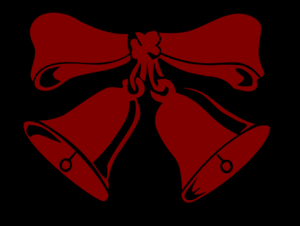
The 11th Royal Fusiliers also got ready for war on September 2. They were immediately sent to guard the explosives factory at Waltham Abbey. Later, a company was stationed at the Tower of London. Guards were also provided for No 4 Balloon Centre and RAF Hendon. The battalion's main office was at Regent's Park Barracks. It later moved to Potters Bar. The 2nd London Division was organized as a motor division. By May 1940, it was stationed around London.
After the British Expeditionary Force (BEF) left Dunkirk, the division became a standard infantry division. This was for home defense. It was first in East Anglia, then in South Wales. The 11th Royal Fusiliers were at Tenby. They moved to Malvern for the winter. On November 21, the 2nd London Division got its old name back: 47th (2nd London) Division. On February 16, 1941, the 47th (2nd L) Division moved to West Sussex. They manned coast defenses. The 11th Royal Fusiliers guarded a 12-mile stretch of coast.
The 47th (2nd L) Division focused on training. The 11th Royal Fusiliers provided many instructors. But in December 1941, the division's role changed. It was unlikely to serve overseas. Its job was to defend the coast and provide new soldiers for other units. The 11th Royal Fusiliers defended the coast between Christchurch Harbour and Lymington Harbour. Lt-Col R.E.J.St G.T. Ransome became the new commanding officer.
Bruneval Raid
The 11th Royal Fusiliers did not see active service as a whole battalion. But a small group was in action during the Bruneval Raid (Operation Biting). Captain J. Bune and selected non-commissioned officers (NCOs) and men from the anti-aircraft platoon helped. They manned the guns on the boats used to pick up paratroopers. This was after a raid on a German radar station on the French coast. The extraction was carefully practiced. The men learned to fire their automatic weapons at 500 yards.
On the night of the raid (February 27/28, 1942), the boats approached the French coast. The men could hear the paratroopers fighting ashore. When the first boats landed to pick up the paratroopers, firing started from the clifftop. The fusiliers fired back. They silenced the enemy. The returning boats avoided German ships. At daylight, they had a fighter escort back to England.
In April, the 11th Royal Fusiliers gave a demonstration of battalion tactics. This was at Larkhill. Senior Allied generals and VIPs, including Prime Minister Winston Churchill, watched. However, the battalion then began to lose soldiers. They sent new soldiers to the 8th and 9th Royal Fusiliers. By August 1, it had only 23 officers and 495 other ranks. In December 1942, the 11th Royal Fusiliers received new soldiers from the 16th Royal Fusiliers. In November 1943, they received part of the 17th Royal Fusiliers. But many of the new soldiers were not fit for infantry duty. The battalion was considered non-operational.
In January 1944, the 47th (2nd L) Division moved to Hartlepool. It then returned to Hampshire. After D Day, the divisions with lower numbers of soldiers were reduced. This was to provide new soldiers for the fighting units. The 11th Royal Fusiliers was effectively disbanded on August 30. It was officially put into suspended animation on October 3, 1944.
After the Wars
When the Territorial Army (TA) was reformed on January 1, 1947, the 8th and 11th Battalions were combined. They became a single 8th Battalion at Handel Street. It was part of the 168 Lorried Infantry Brigade. This brigade was in the 56th (London) Armoured Division. The 56th Division became an infantry division again in 1955. The 8th Royal Fusiliers then transferred to the 167 (City of London) Brigade.
The TA was reduced in size after National Service ended. On May 1, 1961, the 8th Royal Fusiliers absorbed another unit. This was the 624th (Royal Fusiliers) Light Anti-Aircraft Regiment. They formed The City of London Battalion. This was the only TA battalion of the Royal Fusiliers.
On April 1, 1967, the TA was reorganized. The battalion became C Company (The City of London Company, Royal Fusiliers), Fusilier Volunteers. This was at Balham. On April 24, 1968, the four English fusilier regiments merged. They formed the Royal Regiment of Fusiliers. The Fusilier Volunteers became its 5th (Volunteer) Battalion. The company was renamed C Company (City of London).
On May 16, 1988, the 5th (V) Battalion was given a dual role. It was linked to both the Royal Regiment of Fusiliers and The Queen's Regiment. It was renamed 8th (Volunteer) Battalion The Queen's Fusiliers (City of London). It still had a C (City of London) Company at Balham. On April 20, 1993, a new London Regiment was created. The 8th Battalion, Queen's Fusiliers, was split up. Part of it formed the new regiment's C (City of London Fusiliers) Company. In 2006, C (City of London) Company was renamed 3 (City of London Fusiliers) Company.
Heritage and Traditions
Uniforms and Badges
In 1876, the 19th Middlesex RVC wore a bluish-grey uniform. It had scarlet trim. They wore a grey cap with black and scarlet bands. When it became a battalion of the Royal Fusiliers, it adopted that regiment's scarlet tunic with blue trim. They kept this for formal dress. The battalion was allowed to use the coat of arms of the City of London as its emblem.
TF units were allowed to carry special flags called Colours. These were given in 1909. The regimental colour of the 1st Londons had the Royal Fusiliers' emblem in each corner. This emblem was the 'United Red and White Rose' (the Tudor rose) with the Imperial Crown.
Honorary Colonels
These people served as Honorary Colonel of the battalion:
- Col Thomas Hughes, founding CO, appointed May 26, 1869
- Gen Sir Daniel Lysons, GCB, appointed June 26, 1880, died January 29, 1898
- Maj-Gen Sir Henry Trotter, GCVO, appointed March 16, 1898
- Sir Herbert Merton Jessel, Baronet, MP, appointed December 2, 1905.
- Henry, Viscount Lascelles (later 6th Earl of Harewood), KG, GCVO, DSO, TD, appointed February 17, 1923
- Col Sir Cullum Welch, 1st Baronet, OBE, MC, Lord Mayor of London, appointed March 16, 1956
- Col Edward Harcourt Hillersdon, DSO, TD, appointed (to City of London Bn) October 20, 1965
Battle Honours
The 1st London Regiment and 8th Royal Fusiliers earned these special honors for their battles: Second Boer War: South Africa 1900–02 World War I: Aubers, Somme 1916, '18, Albert 1916, '18, Flers–Courcelette, Morval, Le Transloy, Arras 1917, '18, Scarpe 1917, '18, Bullecourt, Ypres 1917, Langemarck 1917, Menin Road, Polygon Wood, Passchendaele, Cambrai 1917, Hindenburg Line, Canal du Nord, Valenciennes, Sambre, France and Flanders 1915–18, Gallipoli 1915–16, Egypt 1916 World War II: Djebel Tebaga, North Africa 1943, Salerno, Teano, Monte Camino, Garigliano Crossing, Damiano, Anzio, Gothic Line, Coriano, Croce, Italy 1943–45.
The honors in bold were chosen to be displayed on the King's colour.
Memorials
The 1st London Battalion is listed on the City and County of London Troops Memorial. This memorial is in front of the Royal Exchange. The bronze figure on the right side shows an infantryman. This represents the different London infantry units.
The battalion is also listed on the Royal Fusiliers War Memorial at Holborn Bar. This memorial has a bronze figure of a Fusilier. When it was unveiled on November 4, 1922, the Territorial battalions formed a special Guard of Honour. The battalion's World War I casualties are listed in the Royal Fusiliers' Regimental Chapel. This chapel is in St Sepulchre-without-Newgate in Holborn.
The regimental colours of the 1st Londons are in the Church of St Peter ad Vincula in the Tower of London. These were presented on June 19, 1909. The King's colour of the 2/1st Londons is in the Officers' Mess at the Army Reserve Centre in Balham. The 3/1st's King's colour is in St Sepulchre's.


